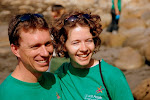
In 2002, the largest wildfire in Colorado's recorded history burned through a valley southwest of Denver. The Hayman fire, as it is known, burned 138,000 acres of land. This land is part of the Upper South Platte River watershed, and the erosion and debris severely affected the water supply to the city of Denver.
Since 2004, Up with People has worked with the coalition of the upper south Platte (or CUSP), to do wildfire reparation work. On Tuesday we took the cast up into the mountains near Buffalo Creek, CO, to do some fire maintenance.

We divided into three groups of about 35 people. One group planted 100 trees across two acres of private land, below the border of the national forest (where the wildlife, burned and dead as it is, can't be touched).

Ellen's group planted native grasses on two more acres. It was a three step process: first we cleared burnt out trees, branches and bark from the land, throwing it into the drainage ravine, where it will be fully burned in the winter. Then we raked the hard-packed, gravelly earth to loosen it up for seed. Two people walked over the property with seeders, which spit eight types of seeds of native grasses on the ground, and we followed behind and covered the bare, patchy areas of seeded gravel with hay. When it rains, the hay will hold the moisture for the seeds to take root.
 Scott's group worked to pull a noxious weed that poisons the ground around it. Knapweed is from Russia, and came to the US in a bin of grain in the early 1900s. It releases a toxin that kills off anything around it, so the native plants and grasses, that are crucial to the forest growing back, are getting squeezed out. Scottie's group pulled weeds until they ran out of garbage bags (they filled over 60!) The bummer about knapweed is that the chemical irritates your skin, so lots of people are nursing itchy, rashy arms. The remedy recommended by our contact was to rub salt on your skin and then rinse it off with cool water. Its had mixed reviews on its success.
Scott's group worked to pull a noxious weed that poisons the ground around it. Knapweed is from Russia, and came to the US in a bin of grain in the early 1900s. It releases a toxin that kills off anything around it, so the native plants and grasses, that are crucial to the forest growing back, are getting squeezed out. Scottie's group pulled weeds until they ran out of garbage bags (they filled over 60!) The bummer about knapweed is that the chemical irritates your skin, so lots of people are nursing itchy, rashy arms. The remedy recommended by our contact was to rub salt on your skin and then rinse it off with cool water. Its had mixed reviews on its success. We worked for about four hours in blazing Colorado sunshine, with sweat pouring from our hardhats. We were covered in dust, dirt, ash, and hay. At the end it was satisfying to look around and see how much we accomplished on our five acres in such a short time, yet so humbling and sad to drive for over 45 minutes to the site through the barren, brown mountains that were in the fire's path. It was a drop in the bucket, but our work will help prevent erosion, which means cleaner water for the city of Denver.
We worked for about four hours in blazing Colorado sunshine, with sweat pouring from our hardhats. We were covered in dust, dirt, ash, and hay. At the end it was satisfying to look around and see how much we accomplished on our five acres in such a short time, yet so humbling and sad to drive for over 45 minutes to the site through the barren, brown mountains that were in the fire's path. It was a drop in the bucket, but our work will help prevent erosion, which means cleaner water for the city of Denver.

1 comment:
Sounds like an amazing time! I recently did something similar in the Sequoia National Park and it was one of the most poignant moments in my life thus far - to connect with the environment in such a way, and to feel like the little you do is making a big difference is an awesome feeling!
Post a Comment